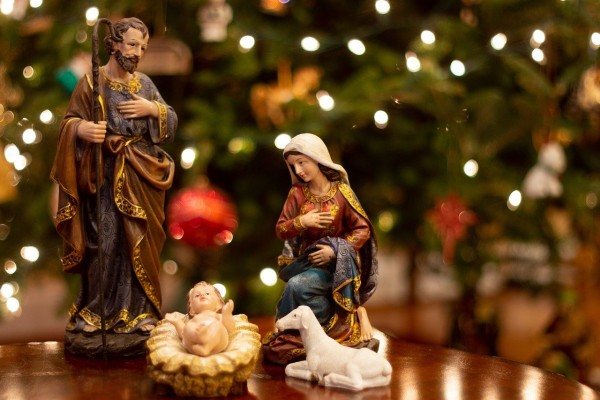
‘God our Father, every year we rejoice as we look forward to this feast of our salvation. May we welcome Christ as our Redeemer, and meet him with confidence when he comes to be our judge.’ (Roman Missal, Vigil Mass of Christmas, Opening Prayer)
With beautiful simplicity, Holy Mother Church reminds us that this miraculous birth we are about to celebrate stands as the fulcrum point of all history. Our Blessed Lady is about to give birth. In every Catholic Church, the faithful (and not so faithful) parishioners and those without a parish are drawn to the Christmas Crib. Why? Modernism and moral relativism have chipped away at the faith of many. Scandal and apathy have hardened many hearts. Life, at its beginning and end, is no longer protected or cared for. The family is attacked in its very definition and spousal love is no longer fruitful or faithful in many homes. Why do they still come, seeking shepherds and angels and looking with longing at the man and woman and their baby?
This Christmas Story speaks of all that this world finds laughable—chastity, virginity, miracles, commitments and promises fulfilled. Perhaps we are still drawn to Bethlehem, the “House of Bread” because we believe that Mary’s son was also God. We still want what He had already given his Mother, the gift of his very life that is sanctifying grace, before he was even born. In Mary, we begin to see the truth of the great exchange we experience in the Eucharist, through the Incarnation, Jesus receives his humanity from his mother’s flesh, while as her redeemer, He makes her a partaker in the divine life. We see eternity, the beginning and the end.
We begin the Church year in advent both remembering the long preparation for Christ’s first advent in the Old Covenant and preparing ourselves for his second advent. Sometimes we assume that everyone understands the necessity of the Incarnation. I think we assume too much.
Beginning in the right place
Good catechesis always begins at the beginning with the end in mind. The Incarnation is not the beginning of the story, yet for many Catholics, the birth of Jesus is just that. Without placing the sweep of human history within the context of God’s divine plan, the Holy child of Bethlehem is frozen forever in the tableau of the stable. It is a charming story, a feel good holiday that has nothing to do with the reality of our creation as children of God, the sin problem that stole our inheritance, or God’s loving initiative to restore the original order of creation, through his Incarnation, life, death, resurrection and ascension and his promise to come again.
If the goal of catechesis is conversion to Christ and eternal beatitude, then our catechesis must be systematic and orderly, firmly rooted in the hierarchy of Truths. We have to resist the temptation to be either wholly program oriented or on the other hand to allow the lectionary to determine the order of teaching doctrine. Our approach cannot be an “either/or”, but must be a “both/and”. Providing a systematic catechesis must recognize that the unity of belief and worship cannot be separated. As John Paul II stated in Catechesi Tradendae, liturgy without catechesis can become a hollow exercise, while catechesis that does not draw folks into the sacred liturgy in incomplete. The Church after all dispenses grace through sacred liturgy, where heaven and earth meet. As catechists we must bring souls to full and active participation in the liturgy, where the grace of Word and Sacrament will inform and transform.
The Christmas Crib
How then does this tableau of the Christmas Crib inform us of the hope of heaven, the reality of our sinful nature and God’s loving plan to save us? What must we know to understand the reality of the Incarnation?
- We must understand who God is. The story of Jesus’ life begins in eternity. The Son, together with the Father and the Spirit, is one God in the eternal communion of the three Persons.
- Adam and Eve were made to share in the divine nature. They were made in God’s image, reflected in their personhood and filled with original grace. With the Fall God’s image was darkened for all of humanity and grace was lost.
- The virgin birth is the result of God’s initiative and Mary’s faith and obedience. The virgin birth is the visible sign of the mystery of the Incarnation, the unity of two natures in one person (CCC 496). The virgin birth shows the “absolute initiative” of God in the Incarnation (CCC 503)
- Born of a virgin, Jesus represents a new beginning for mankind (CCC503). He is the new Adam.
- The virginal birth of Jesus introduces a new form of birth in the new people of God (CCC505) Jesus, conceived by the Holy Spirit in the womb of his mother invites us to be born of the Spirit in the womb of our Mother, the Church.
This final truth is after all the point. The scene of the nativity contains within it the hope for our redemption. When the foundation is laid in good catechesis, truth can penetrate the hearts of those standing at the crib. We are destined for heaven and this child, in this family, holds the key. Grace and contemplation will do the rest, for with God all things are possible.
This article is originally found on page 38 of the printed edition.
Art credit: public domain image from Pixabay.com
This article is from The Sower and may be copied for catechetical purposes only. It may not be reprinted in another published work without the permission of Maryvale Institute. Contact [email protected]
















